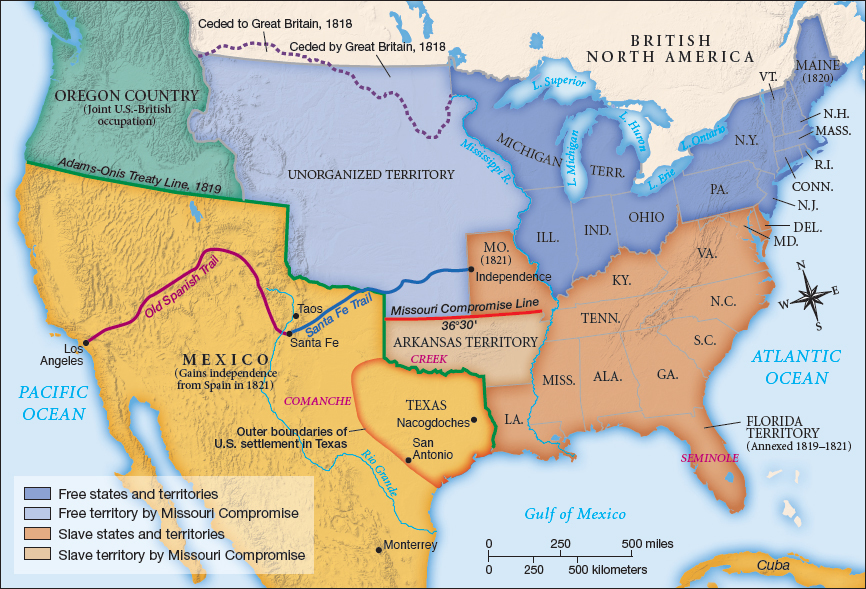Exploring American Histories: Printed Page 269
Exploring American Histories, Value Edition: Printed Page 229
Slavery in Missouri
The spread of slavery fueled a second national crisis. In February 1819, the Missouri Territory applied for statehood. New York congressman James Tallmadge Jr. proposed that it be admitted only if it banned further importation of slaves and passed a gradual emancipation law modeled on those in many northern states. With the support of southern congressmen, however, whites in the territory defeated Tallmadge’s proposals. The northern majority in the House of Representatives then rejected Missouri’s admission.
Southern politicians were outraged, claiming that since the Missouri Territory allowed slavery, so should the state of Missouri. Although the region bordered the Northwest Territory, where slavery was outlawed in 1787, it also bordered the slave states of Kentucky and Tennessee. With cotton production moving ever westward, southern congressmen wanted to ensure the availability of new lands. They also wanted to ensure the South’s power in Congress. Because the northern population had grown more rapidly than that in the South, by 1819 northern politicians controlled the House of Representatives. The Senate, however, was evenly divided, with two senators representing each state: eleven slave and eleven free. If northerners could block the admission of slave states like Missouri while allowing the admission of free states, the balance of power in the Senate would tip in the North’s favor. Thus southern senators blocked the admission of Maine, which sought to separate itself from Massachusetts and become a free state.
For southern planters, the decision on Missouri defined the future of slavery. With foreign trade in slaves outlawed, planters relied on natural increase and trading slaves from older to newer areas of cultivation to meet the demand for labor. Moreover, with free blacks packing the congressional galleries in Washington to listen to congressmen debate Missouri statehood, supporters of slavery worried that divisions among whites could fuel resistance to slavery and even open revolt. Two rebellions had occurred in recent memory. In 1811 some four hundred slaves in Louisiana had killed two whites and burned several plantations. Their advance on New Orleans was stopped only when U.S. troops killed more than sixty rebels. Even more immediately, several hundred fugitive slaves had joined forces with Seminole Indians in 1817, raiding Georgia plantations and establishing autonomous communities in central Florida. Andrew Jackson’s 1818 attack halted their activities, but most of the fugitive blacks escaped deep into Florida.
In 1820 Representative Henry Clay of Kentucky forged a compromise that resolved the immediate issues and promised a long-term solution. Maine was to be admitted as a free state and Missouri as a slave state, thereby maintaining the balance between North and South in the U.S. Senate (Map 9.3). At the same time, Congress agreed that the southern border of Missouri—latitude 36°30’—was to serve as the boundary between slave and free states throughout the Louisiana Territory.

Explore
Compare two critiques of the Missouri Compromise in Documents 9.2 and 9.3.
The Missouri Compromise gained the support of a majority of representatives and senators and ended the crisis for the moment. Still, the debates made clear how quickly a disagreement over slavery could escalate into clashes that threatened the survival of the nation.
Review & Relate
|
What were the political consequences of the panic of 1819? |
What regional divisions did the conflict over slavery in Missouri reveal? |